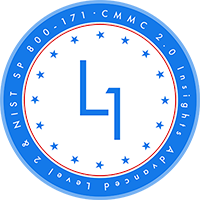
CMMC 2.0 Insights
Level 2
NOW AVAILABLE:

CERTIFIED CMMC PROFESSIONAL COURSE (CCP)
Who is This Course For?
-
Licensed Training Providers (LTPs)
-
Certified Third-Party Assessor Organizations (C3PAOs)
When educating people on a complex, multi-dimensional topic, the best place to start is with its key, foundational information. That’s exactly what Celerium’s Certified CMMC Professional Course (CCP) does – it conveys the fundamental knowledge needed to train professionals supporting the implementation of CMMC.
Select Domain for Level 2
Domain Name
Access Control (AC)
Audit & Accountability (AU)
Awareness & Training (AT)
Configuration Management (CM)
Identification & Authentication (IA)
Incident Response (IR)
Maintenance (MA)
Media Protection (MP)
Personnel Security (PS)
Physical Protection (PE)
Risk Assessment (RA)
Security Assessment (CA)
Systems & Communications Protection (SC)
System & Information Integrity (SI)
Sponsored by Celerium
Sponsored by Celerium
CMMC Insights:
Training on Implementation by Implementers
These online-only courses provide CMMC training to companies looking to comply with CMMC. The courses are created by an experienced team of cybersecurity implementers with years of experience on NIST standards.
Implementing CMMC will be different for every company. And with the U.S. government doubling down on cybersecurity, it's important to get it right. So where is the best place to start?
Our CMMC Insights courses were created to help companies looking to comply with CMMC understand how to implement the practices. Our team has years of experience implementing NIST 800-53.
One-year access to the learning portal is provided, and we will provide updates on changes to CMMC as clarity is provided on items such as reciprocity. Don't wait -- get started on your CMMC assessment preparation now.
Presented by
CMMC Academy Sponsors


international alliance members



| DOMAIN: Identification and Authentication |
|
Practice:IA.L1-3.5.1
|
CAPABILITY: C015 Grant access to authenticated entities
|
|
Identify information system users, processes acting on behalf of users, or devices. |
|
Threat Actors:
Identification of users is a prerequisite for granting access to resources and prevents unauthorized individuals or processes from accessing the system, while identification and authentication of users is the basis for many types of access control and user accountability. Without this accountability threat actors could compromise a user account and perform actions that may be difficult to detect, as there would be no identifiers attributed to the compromised account.
Assessment NOTES: A CMMC assessor may want to review, observe, or test the following· Service or group accounts used by the organization
· Policy or procedures on method(s) used to uniquely identify and authenticate users.
· Organizational procedures to remove access to service or group accounts when an individual terminates or due to change in job responsibilities e.g., an individual is transferred to another business unit.
Click here to see details|
Practice:IA.L1-3.5.2
|
CAPABILITY: C015 Grant access to authenticated entities
|
|
Authenticate (or verify) the identities of those users, processes, or devices as a prerequisite to allowing access to organizational information systems. |
|
Threat Actors:
Poor authentication practices can lead to compromise. Using weak passwords with only single-factor authentication is a dangerous security practice and could lead to compromise with the use of password crackers and brute-force techniques. Implementing a stronger multi-factor identification mandate is preferred - requiring two forms of authentication for access.
Assessment NOTES: A CMMC assessor may want to review, observe, or test the following· An account provision process to examine identified methods of authentication.
· The use of unique accounts for new employees and contractors
· The use and assignment of initial passwords
· A password reset function for initial use
· The requirement for password complexity, such as 12 characters, a mix of upper and lower case letters, number, and special characters.
Click here to see detailsCopyright © 2022 Celerium. All Rights Reserved.




